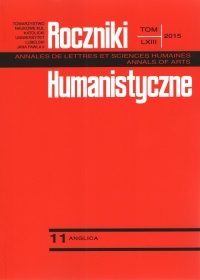“I came a long way to get here”: Narrative point of view, the trope of the journey and recontextualization in Kaye Gibbons’s Ellen Foster and its cinematic adaptation
Abstrakt
„Przeszłam długą drogę, aby tutaj dotrzeć”: Narracyjny punkt widzenia, trop podróży i rekontekstualizacja w Kaye Gibbons Ellen Foster i jej filmowej adaptacji
Przesłanką teoretyczną artykułu jest analiza procesu adaptacji dyskursu narracyjnego i rozległego spektrum tematycznego, przeprowadzona w oparciu o ekranizację powieści Kaye Gibbons Ellen Foster z 1987 r. Głównym celem artykułu jest ukazanie sposobu prezentacji narracyjnego punktu widzenia oraz zagadnień tematycznych przeniesionych z literackiego pierwowzoru do filmu o takim samym tytule z serii the Hallmark Hall of Fame. Dokładnej analizie zostały poddane słowa występujące w zakończeniu dzieł, posługujących się odmiennymi środkami przekazu, rozpatrywane w kontekście retorycznym i logicznym. Oddzielne miejsce zostało poświęcone kwestii spójności obydwu mediów z dyskursem kulturowym, w który się wpisują.
Bibliografia
Abel, Elizabeth. “(E)Merging Identities: The Dynamics of Female Friendship in Contemporary Fiction by Women,'' Signs: Journal of Women in Culture and Society 6.3 (1981): 413-35.
Bordwell, David. Narration in the Fiction Film. Madison, Wisconsin: The University of Wisconsin Press, 1985.
Casetti, Francesco. “Adaptation and Mis-Adaptations: Film, Literature, and Social Discourses.” A Companion to Literature and Film. Ed. Robert Stam and Alessandra Raengo. Oxford: Blackwell Publishing, 2008. 81-91.
DeMarr, Mary Jean. Kaye Gibbons: A Critical Companion. Westport, Connecticut: Greenwood Press, 2003.
Ellen Foster. Dir. John Erman. Perf. Glynnis O’Connor, Jena Malone, Julie Harris, and Debra Monk 1997. Hallmark Hall of Fame.
Genette, Gérard. Narrative Discourse: An Essay in Method. Ithaca, New York: Cornell University Press, 1980.
Gibbons, Kaye. Ellen Foster. New York: Vintage, 1987.
Groover, Kristina. “Re-visioning the Wilderness: Adventures of Huckleberry Finn and Ellen Foster.” Southern Quarterly 37.3/4 (Spring/Summer 1999): 187–97.
The Hallmark Hall of Fame. http://www.hallmark.com/online/hall-of-fame/ Date of access: 10 May 2015.
hooks, bell. Where We Stand: Class Matters. New York: Routledge, 2000.
McFarlane, Brian. Novel to Film. An Introduction to the Theory of Adaptation. Oxford: Clarendon Press, 1996.
Monaco, James. How to Read a Film. New York: Oxford University Press, 1981.
Newitz, Annalee and Mathew Wray. “What is ‘White Trash’? Stereotypes and Economic Conditions of Poor Whites in the United States.” Whiteness: a Critical Reader. Ed. Mike Hill. New York: New York University Press, 1997. 168–84.
Penley, Constance. “Crackers and Whackers: The White Trashing of Porn.” White Trash: Race and Class in America. Ed. Newitz Annalee and Matt Wray. London: Routledge, 1996.
Powell, Dannye Romine. Parting the Curtains: Interviews with Southern Writers. Winston-Salem, NC: John F. Blair Publisher, 1994.
Reames, Kelly Lynch. Women and Race in Contemporary U.S. Writing. From Faulkner to Morrison. New York: Palgrave MacMillan, 2007.
Reed, John Shelton. Southern Folk, Plain and Fancy: Native White Social Types. Athens: University of Georgia Press, 1988.
Snodgrass, Mary Ellen. Kaye Gibbons: a Literary Companion. Jefferson, N.C.: McFarland, 2007.
Stam, Robert, Robert Burgoyne and Sandy Flitterman-Lewis. New Vocabularies in Film Semiotics. Structuralism, Post-structuralism and Beyond. London: Routledge, 1992.
Wagner, Geoffrey. The Novel and the Cinema. Rutherford, NJ: Fairleigh Dickinson University Press, 1975.
Wray, Matt. Not Quite White: White Trash and the Boundaries of Whiteness. Durham: Duke University Press, 2006.
Copyright (c) 2015 Roczniki Humanistyczne

Utwór dostępny jest na licencji Creative Commons Uznanie autorstwa – Użycie niekomercyjne – Bez utworów zależnych 4.0 Międzynarodowe.





